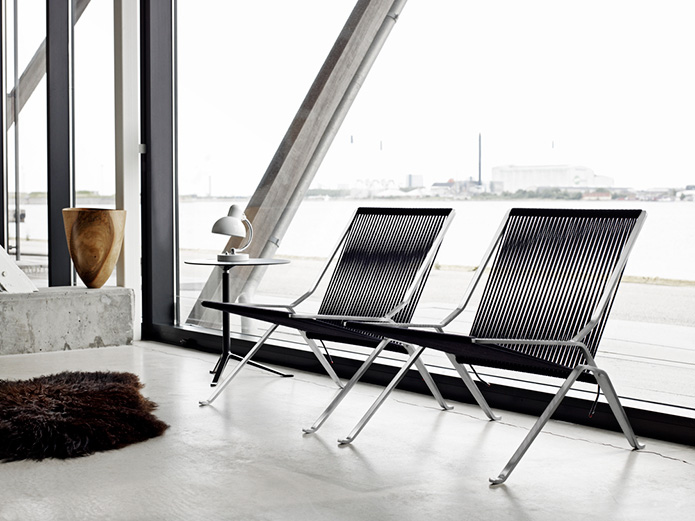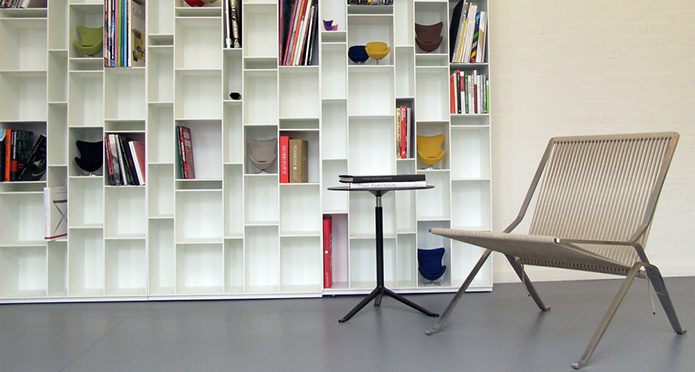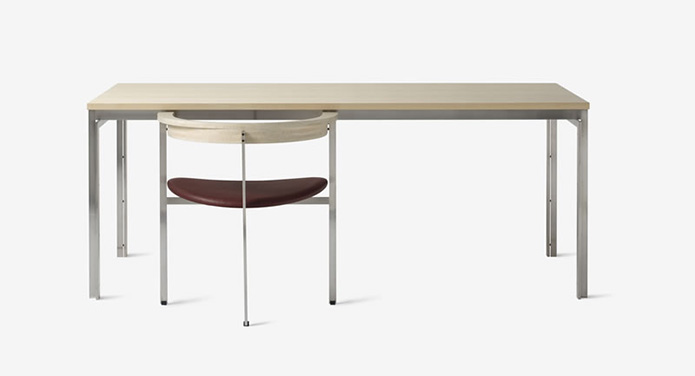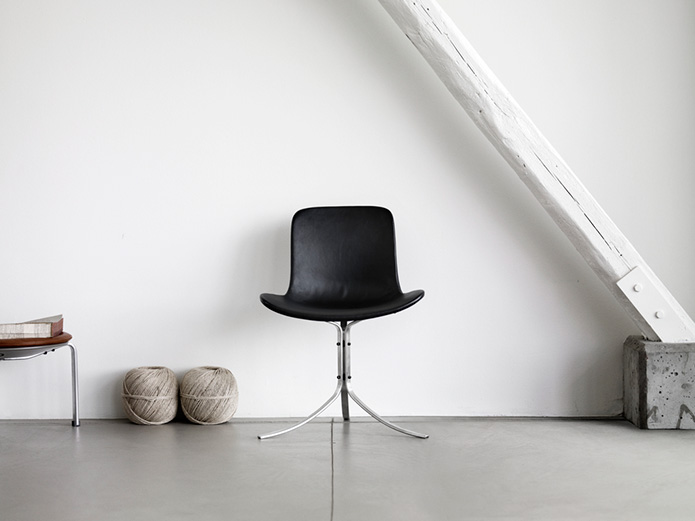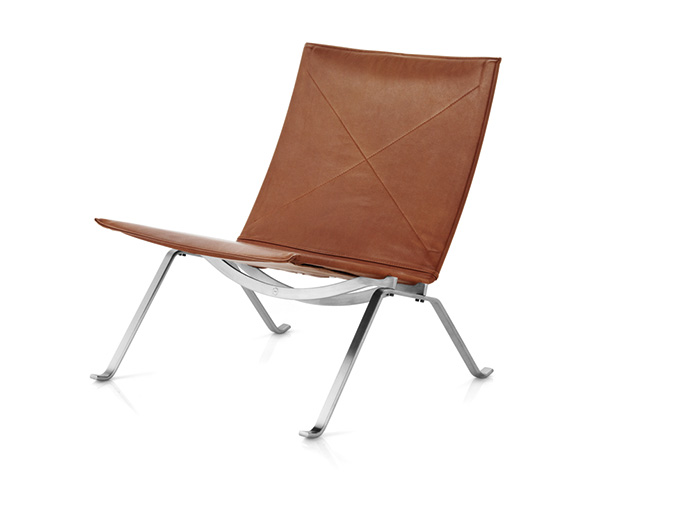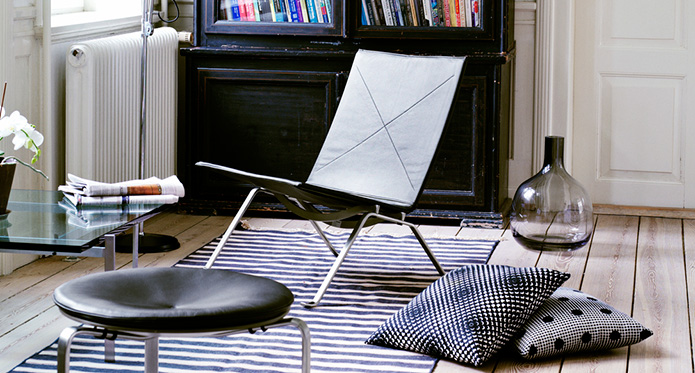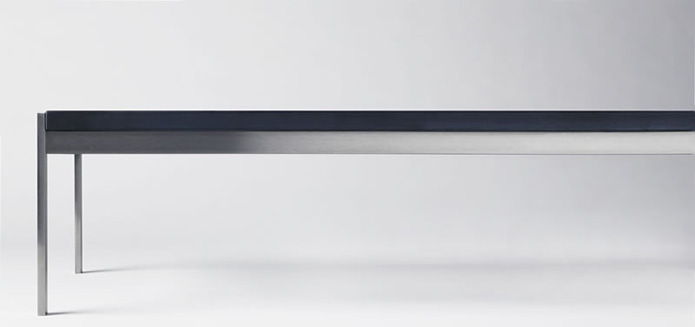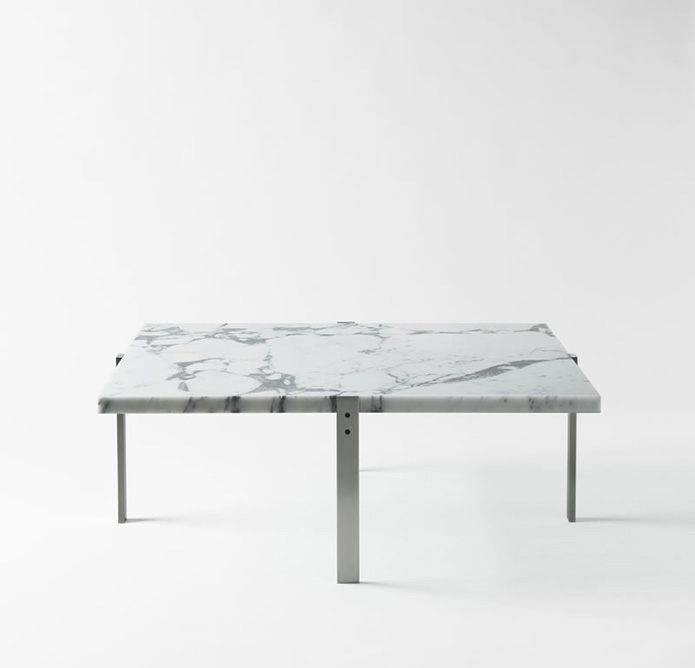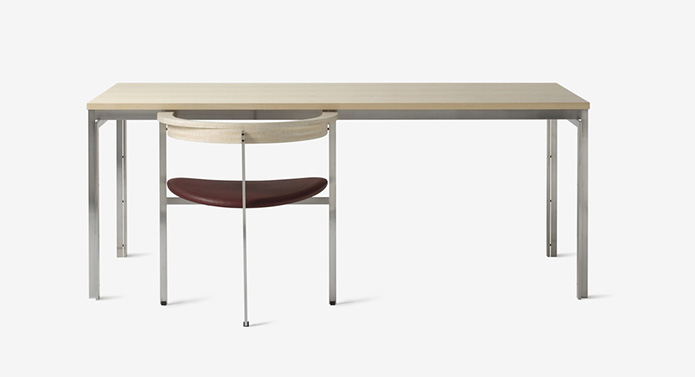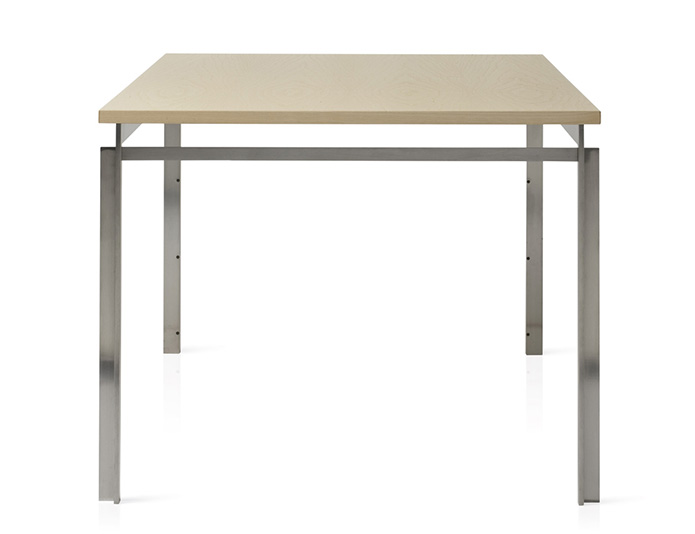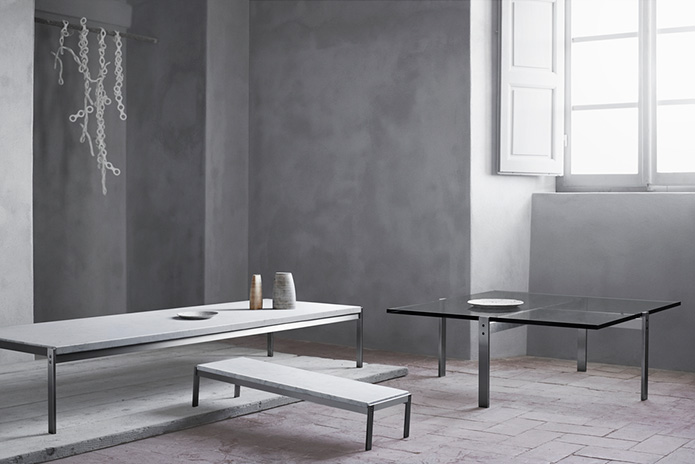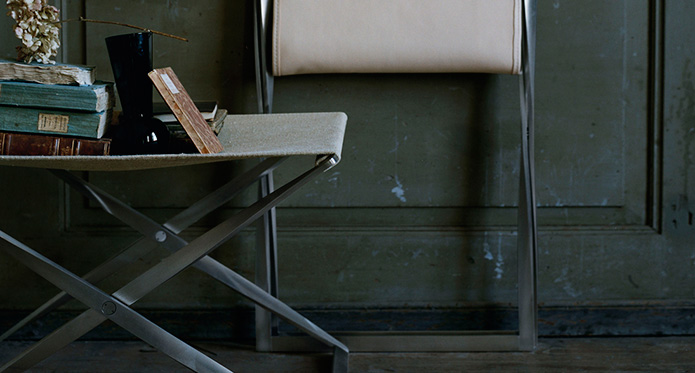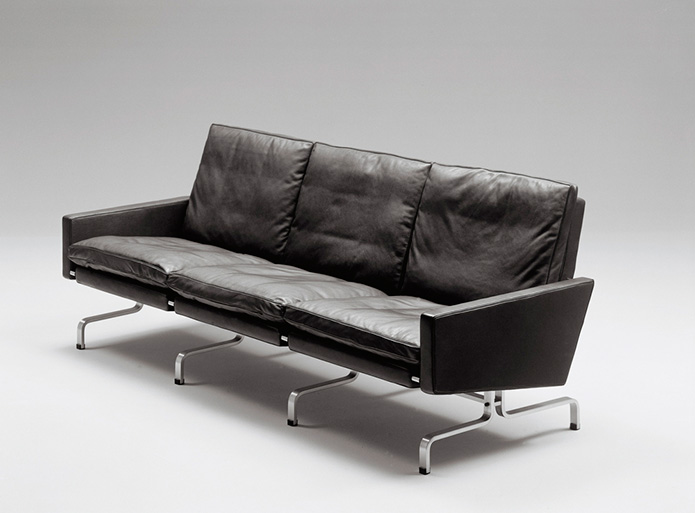
Portrait of Poul Kjærholm. Image © Republic of Fritz Hansen
The word ‘genius’ is often overused, particularly to describe inane concepts, acts or people. As such, its true meaning can be diluted. More than just intellect, someone’s genius can be used to describe their creativity, talent and skill, where they are a master at some given craft.
Poul Kjærholm was a Danish master craftsman, a design genius and a modern innovator. His flame burned brightly but was extinguished much too soon – Kjærholm was just 51 when he died in 1980. Through his design legacy, we arguably have a collection of some of the finest Danish furniture ever imagined.
Kjærholm was born in Østervrå on 8th January 1929. In 1948 he received a certificate of apprenticeship from the workshop of master cabinetmaker Th. Grønbech. In 1949, he enrolled at the Furniture School in Copenhagen’s School of Arts and Crafts. Here Kjærholm was supervised by the celebrated Hans J. Wegner, his mentor and soon to be contemporary. A significant influence on the young Kjærholm, Wegner also employed him part-time in his design studio between 1950 and 1952. Kjærholm completed his first major design piece in 1951, named the PK25. He graduated from the School of Arts and Crafts in 1952 and the PK25 was exhibited at the Danish Museum of Art and Design in the spring of that year. The chair caught the eye of Søren Hansen, then director of Fritz Hansen, who employed Kjærholm at Fritz Hansen’s factory and put the PK25 into limited production. At just 23 years old, Poul Kjærholm was a rising design star.
Poul Kjærholm was a ‘furniture architect’, a term he preferred to the label of designer. In essence ‘furniture architect’ reflected the idea that furniture engages in a form of discourse with the space in which it is situated. Kjærholm demanded much from his furniture, particularly in terms of aesthetic and design. He pushed materials to their greatest potential and believed in clarity of the aesthetic, where designs were simple and pure. With Kjærholm’s work there is a purity that flows from construction to the finished piece and indeed the context in which his furniture is placed demands finesse and precision.
Poul Kjærholm’s furniture designs are mainly midcentury in terms of a timeline, yet his work is not bounded by any era. It is equally at home in today’s contemporary modern society. The PK9 for example is a side chair that was designed in 1960. The chair is upholstered in leather and its base is made of satin brushed stainless steel. Despite being over 50 years old, it retains a modern industrial feel that works well in many contemporary interiors.
The PK22 lounge chair, perhaps Kjærholm’s best known piece, was designed in 1956. An exercise in perfect form, its profile directly relates to the PK25. In 1957, the PK22 was awarded the Grand Prix at the Milan Triennale. It is, in this author’s opinion, a more than worthy contender to the Barcelona Chair and the finer of the two.
For many Poul Kjærholm collectors and those fortunate enough to own a piece of his furniture, his designs emanate exclusivity and provide an indulgence. For others who can only wish to own a Kjærholm design, his work in many ways represents a kind of design nirvana. Each piece is crafted with the intention of being functional, unobtrusive and long-lasting. More than this, its modern minimal aesthetic is timeless, enduring and classic. Poul Kjærholm’s vision for his furniture is far removed from today’s consumeristic, throwaway society. Rather than being changeable, competitive and unprincipled, Kjærholm’s work is imbued with a master craftsman’s integrity, gravitas and polish.
A Poul Kjærholm piece has the appearance of a simple object, with its clean lines and lack of ostentation, yet it involves much mastery, love of clarity and attentiveness to detail. The summation of all of this is perfection, with furniture that is far from ordinary, but rather manifestly precise and urbane. A work of art that hangs in a gallery can be destroyed by someone’s deliberate act of vandalism. Similarly, to litter a Kjærholm chair or a sofa with cushions and throws, would be to misrepresent Poul Kjærholm’s ideal state. “Kjærholm sought to create nothing less than archetypes, pieces of furniture that were reduced to their essential form, in order to express the basic idea of a chair or a stool or a table.” (Excerpt from Poul Kjærholm, Furniture Architect).
Poul Kjærholm’s name is not one that people are immediately familiar with, at least not when compared with contemporaries such as Arne Jacobsen and Hans J. Wegner. Yet his furniture is both unmistakeable and equally well placed beside those other notable design luminaries. Kjærholm’s work is like a critically acclaimed independent film, one shown in worthy art houses. Its box office figures may not have broken any records, but its fans and followers are devout and resolute in their praise. Poul Kjærholm’s furniture has a distinct edge. For design aficionados and collectors, its ‘art house’ status only serves to make it more attractive and covetable.
Discussing plans for the Poul Kjærholm collection within Fritz Hansen, Jan Vejsholt, Vice President UK, Ireland & Middle East for Republic of Fritz Hansen, revealed that Kjærholm’s work was being reviewed given the wealth of products within the Kjærholm collection. Of the collection he said: “We’re very close to the foundation and the family and I can imagine there will be more Kjærholm products that will be launched in the coming years – more of the old collection that hasn’t been seen for a while. Poul Kjærholm’s family are, rightly so, very precise in terms of what we can and can’t do with his products, which is exactly how it should be. [In the UK] Arne Jacobsen is much more well known than Poul Kjærholm, so we have a duty to Kjærholm’s beautiful furniture to make it more familiar. It is very minimal though to the average UK person, so we are on a journey in getting people to view Kjærholm as an object they could buy into” (Source: Walnut Grey Design).
In 2003, Fritz Hansen made the decision to cease production of several Poul Kjærholm designs, mainly tables and one chair (the PK11). At that time, Poul Kjærholm’s son, Thomas Kjærholm, then produced the halted designs under the banner of ‘Kjærholm Production’. In January 2014, Fritz Hansen reacquired the rights for these designs from Thomas Kjærholm, granting them license to produce the entire Poul Kjærholm Collection (Fritz Hansen was already producing a number of Kjærholm’s designs).
Those missing pieces returned to the Fritz Hansen collection are the PK11, PK51/PK55, PK62, PK63/PK63A and PK65. Fritz Hansen’s decision to acquire the rights to the entire Poul Kjærholm Collection is due, the company observes, “to an increased interest internationally in Danish design in general and in Poul Kjærholm in particular.” (Source: Fritz Hansen press release).
Poul Kjærholm’s longevity owes much to the materials used in his designs. “Kjærholm’s things are tangible. They are physical. They are heavy. They are in every way the epitome of the materials of which they are made, and in this they hark back to a Danish tradition where craftsman-like integrity and love of the material take centre stage.” (Excerpt from Poul Kjærholm, Furniture Architect). Poul Kjærholm’s designs use materials that include hides, wicker, glass, steel and marble, refined from their raw state into one of beautiful elegance. Materials, carefully selected and sourced, are of the highest quality and sustainability. Their natural state adds an element of individuality to every piece. For Paul Kjærholm, expressing the material’s personality was uppermost in his mind – “I am trying to express the very language of the materials themselves” (Source).
Poul Kjærholm died on 18th April 1980. His son, Thomas Kjærholm, fittingly said that “he died much to soon… but not before he had designed some of Scandinavia’s – even the world’s – most beautiful pieces of furniture” (Source). Poul Kjærholm, furniture architect, was exemplary.
Source used for article: Poul Kjærholm, Furniture Architect (2008). Republic of Fritz Hansen.
Gerard McGuickin is a freelance design writer and a blogger for his online zine, Walnut Grey Design. He writes intelligently about ‘good design’ from the viewpoint of interiors, architecture, objects and lifestyle. Gerard has a specialist interest in modern contemporary Nordic and British design.

